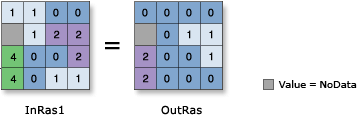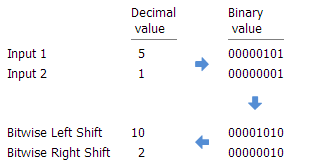Available with Image Analyst license.
Available with Spatial Analyst license.
Overview
Performs a Bitwise Right Shift operation on the binary values of two input rasters.

Notes
Two inputs are necessary for this function to execute.
The order of the inputs is irrelevant for this function.
If an input is floating-point data type, the values are converted to integer values through truncation before the bitwise operation is performed.
All bitwise operations have the following in common:
- Binary values are stored in two's complement.
- The tools work on 32-bit integers.
- The leftmost bit position is reversed for the sign (positive or negative) of the value. If the integer is positive, the bit position is 0; if it's negative, the bit position is 1.
The Bitwise Right Shift operation does no wrapping of bits. The rightmost bit is dropped.
If both inputs are single band rasters, or one of the inputs is a constant, the output will be a single band raster.
If both inputs are multiband rasters, the function will perform the operation on each band from one input, and the output will be a multiband raster. The number of bands in each multiband input must be the same.
If one of the inputs is a multiband raster and the other input is a constant, the function will perform the operation against the constant value for each band in the multiband input, and the output will be a multiband raster.
If both inputs are multidimensional rasters with same number of variables, the function will perform the operation for all slices with same dimension value, and the output will be a multidimensional raster. The variables in the inputs must have same dimensions or a common dimension but no uncommon dimensions.
If one of the inputs is a multidimensional raster and the other input is a constant, the function will perform the operation for all slices for all variables against the constant value, and the output will be a multidimensional raster.
Parameters
| Parameter name | Description |
|---|---|
Raster | The input on which to perform the shift. A constant value can be used as an input for this parameter, provided a raster is specified for the other parameter. |
Raster2 | The input defining the number of positions to shift the bits. A constant value can be used as an input for this parameter, provided a raster is specified for the other parameter. |
Extent Type | Choose which extent should be used in the output raster:
|
Cellsize Type | Choose which cell size to use in the output raster. If all the input cell sizes are the same, all the options will yield the same results.
|
Learn more about bitwise
The bitwise tools evaluate the binary representation of the input values on a pixel-by-pixel basis. For each bit in the binary representation, a Boolean operation is performed.
The logic of how the various bitwise tools operate is illustrated in the following sections. The arrows are used to indicate the flow of operation of how input values are converted to a base2 binary representation, analyzed, and returned as a decimal (base10) value.
Learn more about how Bitwise Right Shift works
The arrows in the following illustration demonstrate that the input values are first converted to their binary representation, the bitwise logic is applied to each pair of bits that represent those values, and the values are finally converted back to a decimal representation.
For Bitwise Right Shift, the value for each bit is shifted to the right by the number of bit positions specified in the second input. The value that is assigned to the farthest right bit is lost. The effect of a right shift by one bit position is a division by two with truncation.

Note:
If any of the input pixel values is NoData, the output value will be NoData.